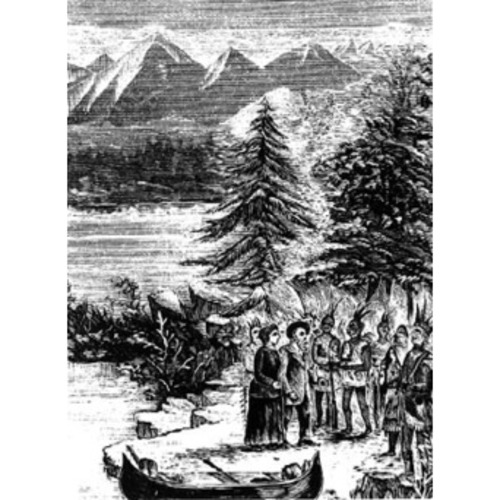
Source: Link
GABOURY, MARIE-ANNE (Lagimonière), first white woman to settle in the west, grandmother of Louis Riel*; b. 15 Aug. 1780 in Saint-Antoine-de-la-Rivière-du-Loup (Louiseville), fifth child of Charles Gaboury (Gabourie) and Marie-Anne Tessier (Thésié); d. 14 Dec. 1875 at Saint-Boniface, Man.
Following the death of her father on 7 Dec. 1792, Marie-Anne Gaboury went into domestic service as the assistant housekeeper to the parish priest of Maskinongé. She remained there until her marriage, on 21 April 1806, to Jean-Baptiste Lagimonière* (sometimes written Lajimonière or Lagimodière), who traded furs in the northwest and likely came from Saint-Antoine-sur-Richelieu.
Immediately following her marriage she travelled with her husband by canoe from Montreal to Fort Gibraltar, at the junction of the Red and Assiniboine rivers in present-day Winnipeg. It was a long, arduous journey that ended when they arrived at a Métis encampment on the Pembina River in late August. Her first child was born on 6 Jan. 1807 at Fort Daer (Pembina, N.D.). The date being the church festival of the Epiphany, the baby girl was named Reine in honour of the Magi.
The following spring the Lagimonières left Fort Daer for the Saskatchewan valley. At Cumberland House, Marie-Anne and her daughter were welcomed as the first white females to have ventured thus far into the interior of the Hudson’s Bay Company territories. Finally, at the end of August, they found themselves in the region around the North Saskatchewan River, where they remained from 1807 until 1811. In 1810 Alexander Henry* met Lagimonière and his family at Paint Creek (Vermilion River). During these years Marie-Anne accompanied her husband on the many hunting expeditions that were essential to the western free-trader’s way of life, experiencing to the full the hardships and privations that were the lot of the pioneer woman. Several more children were born to them.
When news arrived that a permanent colony was to be started under the initiative of Lord Selkirk [Douglas*] along the Red and Assiniboine rivers, Lagimonière and his family returned to Red River. They reached the community towards the end of August. The colony was still being developed, and they continued their journey to Fort Daer. In the spring they returned to the newly established Red River Settlement. The North West Company, regarding the project as an HBC scheme to cripple its trade, undertook its destruction. Marie-Anne and her husband witnessed but took no part in the struggle between the Nor’Westers and the Selkirk settlers. However, in October 1815 Colin Robertson*, the HBC representative in the region, anxious to communicate with Lord Selkirk, employed Jean-Baptiste Lagimonière to carry dispatches to the earl in Montreal. He made the journey during the winter of 1815–16, travelling over 1,800 miles on foot with another employee, Bénoni Marier, and an Indigenous guide. The mission succeeded, but on the return journey he was taken prisoner by Indigenous allies of the North West Company. He was imprisoned in Fort William and remained there until August 1816, when he was released following Lord Selkirk’s capture of the fort.
Meanwhile Marie-Anne had been compelled to take refuge with local Indigenous communities. On Selkirk’s arrival in September 1816, she was once more reunited with her husband. For his services to the earl, Lagimonière was rewarded with a grant of land lying between the east bank of the Red River and the Seine in the vicinity of what is now Winnipeg. Here he built a frame house in which he, Marie-Anne, and their growing family lived for many years. To the children already mentioned, the Lagimonières added five others, one of whom, Julie (b. 1822), became the mother of Louis Riel.
On 7 Sept. 1855 Marie-Anne’s husband died. She, however, lived to the advanced age of 95. Deprived though she so often was of comforts and necessities, her life had been one of selflessness and devotion. She survived long enough to see the settlement of the west thrive and flourish, and her grandson become the father of the province of Manitoba.
AJTR, Registre d’état civil. Archives de l’archevêché de Saint-Boniface (Man.). Archives de la Société historique de Saint-Boniface (Man.). L’Écho de Louiseville, 4 févr. 1970. HBRS, II (Rich and Fleming), 229. Morice, Dict. hist. Can. et Métis, 116–17. J. M. Gray, Lord Selkirk of Red River (Toronto, 1963), 124–26, 136, 170, 273, 284. Georges Dugas, La première Canadienne du Nord-Ouest ou biographie de Marie-Anne Gaboury, arrivée au Nord-Ouest en 1806, et décédée à Saint-Boniface à l’âge de 96 ans (Montréal, [1883]).
Bibliography for the revised version:
Arch. of Manitoba (Winnipeg), MG 2, A1; MG 8, C1. Bibliothèque et Arch. Nationales du Québec, Centre d’arch. de Montréal, CE601-S13, 5 févr. 1776; CE603-S6, 26 déc. 1778; Centre d’arch. de Trois-Rivières, CE401-S10, 21 avril 1806; CE401-S15, 16 août 1780. Find a Grave, “Memorial no.17403349”: www.findagrave.com (consulted 2 Feb. 2021).
Cite This Article
George F. G. Stanley, “GABOURY, MARIE-ANNE (Lagimonière),” in Dictionary of Canadian Biography, vol. 10, University of Toronto/Université Laval, 2003–, accessed December 16, 2025, https://www.biographi.ca/en/bio/gaboury_marie_anne_10E.html.
The citation above shows the format for footnotes and endnotes according to the Chicago manual of style (16th edition). Information to be used in other citation formats:
| Permalink: | https://www.biographi.ca/en/bio/gaboury_marie_anne_10E.html |
| Author of Article: | George F. G. Stanley |
| Title of Article: | GABOURY, MARIE-ANNE (Lagimonière) |
| Publication Name: | Dictionary of Canadian Biography, vol. 10 |
| Publisher: | University of Toronto/Université Laval |
| Year of publication: | 1972 |
| Year of revision: | 2022 |
| Access Date: | December 16, 2025 |



